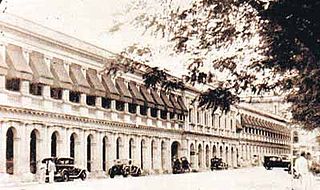A member of parliament (MP) is the representative of the voters to a parliament. In many countries with bicameral parliaments, this category includes specifically members of the lower house, as upper houses often have a different title. Member of Congress is an equivalent term in other jurisdictions.
President of the Senate is a title often given to the presiding officer of a senate. It corresponds to the speaker in some other assemblies.

The President of the Senate is the presiding officer of the Australian Senate, the upper house of the Parliament of Australia.

The speaker of a deliberative assembly, especially a legislative body, is its presiding officer, or the chair. The title was first used in 1377 in England.

The Parliament of the Democratic Socialist Republic of Sri Lanka is the supreme legislative body of Sri Lanka. It alone possesses legislative supremacy and thereby ultimate power over all other political bodies in the island. It is modeled after the British Parliament.
Age of candidacy is the minimum age at which a person can legally qualify to hold certain elected government offices. In many cases, it also determines the age at which a person may be eligible to stand for an election or be granted ballot access.

The Italian Parliament is the national parliament of the Italian Republic. It is the representative body of Italian citizens and is the successor to the Parliament of the Kingdom of Sardinia (1848–1861) and the Parliament of the Kingdom of Italy (1861–1946). It is a bicameral legislature with 945 elected members and a small number of unelected members (parlamentari). The Italian Parliament is composed of the Chamber of Deputies and Senate of the Republic. The two Houses are independent from one another and never meet jointly except under circumstances specified by the Constitution of Italy.

The parliament of Poland has an upper house and a lower house. Both houses are accommodated in the Sejm complex in Warsaw. The parliament itself is without an official name; the Constitution refers only to the Sejm and the Senate.

The Senate of Kazakhastan is the upper house of two chambers in Kazakhstan's legislature, known as the Parliament (Parlamenti). The Senate is composed of elected members - two from each region, the city of republican importance (Almaty) and the capital city of the Republic of Kazakhstan at joint sessions of the members of all representative bodies of respective regions, city of the republican importance and the capital city of the Republic.

The politics of Australia take place within the framework of a federal parliamentary constitutional monarchy. Australia has maintained a stable liberal democratic political system under its Constitution, one of the world's oldest, since Federation in 1901. Australia is the world's sixth oldest continuous democracy and largely operates as a two-party system in which voting is compulsory. The Economist Intelligence Unit rated Australia a "full democracy" in 2018. Australian is also a federation, where power is divided between the federal government and the states and territories.

The Speaker of the Parliament of the Democratic Socialist Republic of Sri Lanka is the presiding officer of the chamber. The current Speaker of the Parliament is Karu Jayasuriya, in office since 1 September 2015. The Speaker fulfills a number of important functions in relation to the operation the House, which is based upon the British Westminster Parliamentary system.

The Senate was the upper chamber of the parliament of Ceylon established in 1947 by the Soulbury Commission. The Senate was appointed and indirectly elected rather than directly elected. It was housed in the old Legislative Council building in Colombo Fort and met for the first time on 12 November 1947. The Senate was abolished on 2 October 1971 by the eighth amendment to the Soulbury Constitution, prior to the adoption of the new Republican Constitution of Sri Lanka on 22 May 1972. In 2010 there were proposals to reintroduce the Senate.
Reginald Sydney Vernon Poulier, was a Ceylonese statesman and civil servant.
Ranawaka Arachchige Arthur Reginald Perera was Sri Lankan Trotskyist politician.
Clodagh Jayasuriya, MBE, was a Ceylonese politician and the first female to be elected to the Senate of Ceylon.
Cyril Eugene Attygalle was a Ceylonese politician.

Jayaweera Kuruppu was a Ceylonese politician.
Mudaliar Al-Haj Meerakuddy Mohamed Ebrahim was a former Muslim Member of Parliament representing Pottuvil.













